Contents:
Lincoln Penny is one of the most recognizable US coins. It had a ton of releases, and 1985 was one of them.
Is a 1985 penny worth anything? Read this article to find out! You will also learn about many varieties of the 1985 penny and the errors it might have.
Did you know you can check coin value with phone apps?
Lincoln Penny Design
The obverse of this coin was designed by Victor David Brenner in 1909 and has barely changed ever since. Reverse, on the other hand, saw some revisions. Since 1959, the penny has used a memorial-themed reverse by Frank Gasparro.
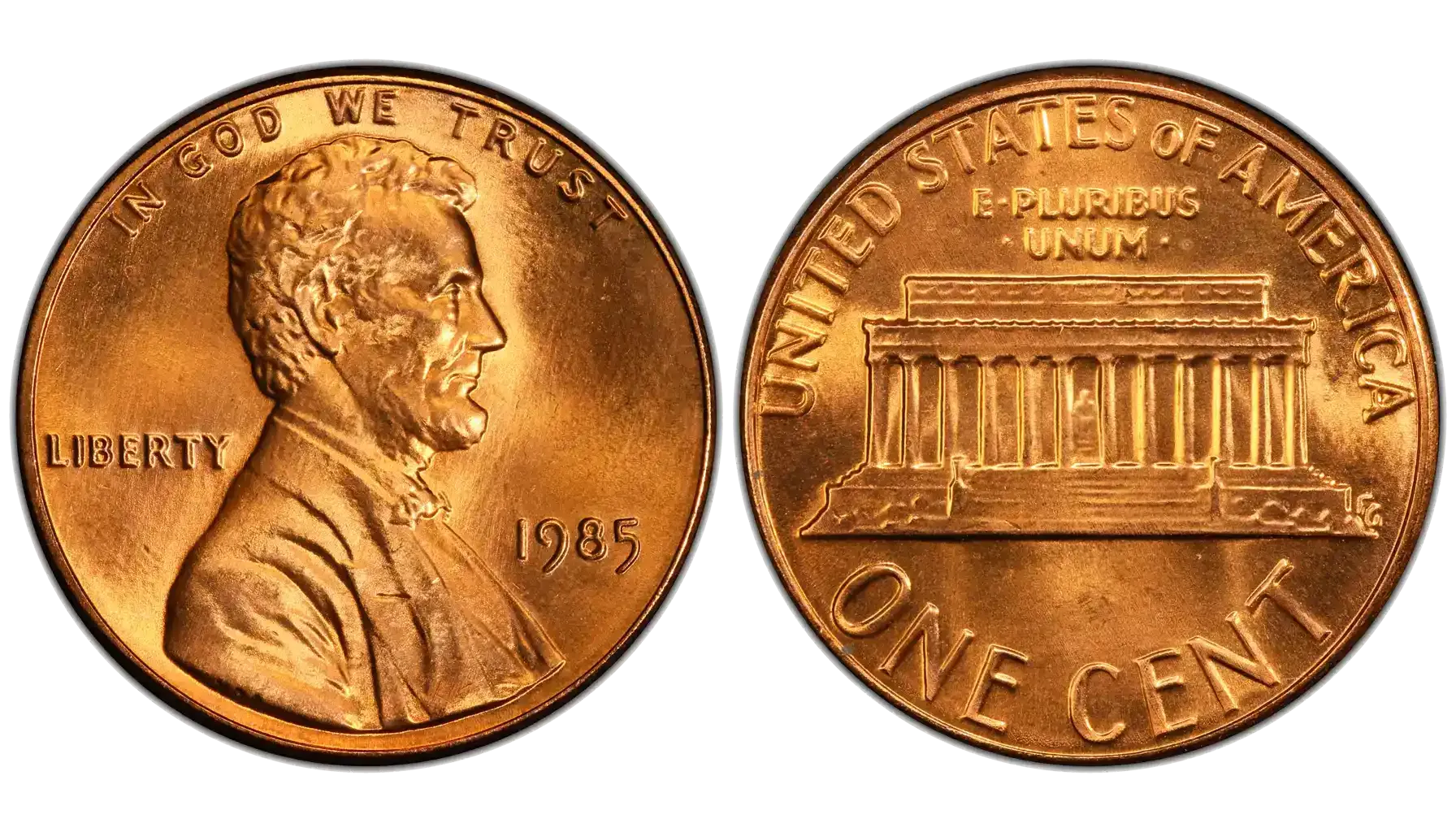
Obverse: A right-facing profile of Abraham Lincoln, the 16th President of the United States. Inscriptions"IN GOD WE TRUST" are on the top edge above Lincoln's head. The word "LIBERTY" is to the left of Lincoln, near his shoulder. The date (1985) is on the right.
Reverse: A depiction of the Lincoln Memorial in Washington, D.C. Inscriptions "UNITED STATES OF AMERICA" arch over the top part. The phrase "E PLURIBUS UNUM" is just above the Memorial. The denomination "ONE CENT" is at the bottom.
Lincoln Penny Overview
It’s good to know the basics about your coin. Otherwise, you might get confused, and your business partner might use this confusion to sell you a counterfeit penny 1985.
For example, some say there’s a 1985 silver penny. Unfortunately, it’s not possible. There’s one main penny, the Lincoln one, and they are all copper-based. Steel used to be a popular coin metal back in the past, so maybe that’s why we have such misconceptions.
The main characteristics of the 1985 Lincoln penny | |
Country | United States |
Years of Minting | 1959-2008 (Memorial reverse) |
Type: | Standard circulation |
Shape: | Round |
Composition and metal content | Bronze (95% Copper, 5% Zinc) |
Diameter | 19 mm |
Weight | 3.11 grams |
The Mints | United States Mint of Denver, United States Mint of Philadelphia, United States Mint of San Francisco |
Lincoln Coins Varieties
Most coins are categorized according to their mint marks, and the Lincoln cent is no exception. Mint marks are little letters that signify the mint facility that made the coin. According to the mint marks, there are:
No mint mark variety (made in the Philadelphia Mint)
D-mark variety (made in the Denver Mint)
S-mark variety (made in the San Francisco Mint)
1985 No Mint Mark Penny
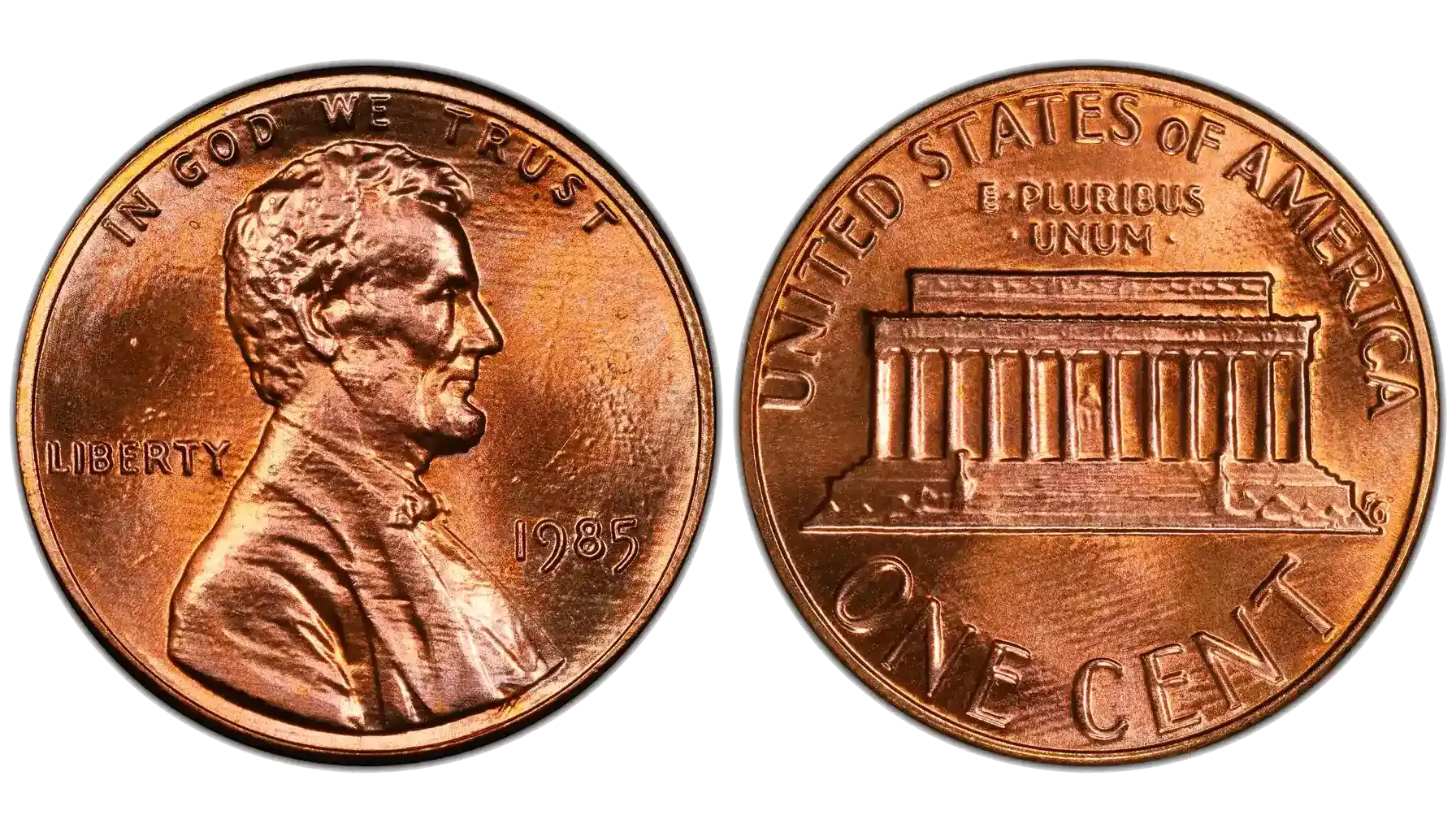
Identify by: a blank space where a mint mark should be (under the date on the obverse).
Mintage: 5,648,489,887.
Estimated value: 1985 penny no mint mark value is $0.01 in circulated conditions, $25+ in uncirculated conditions.
Coins from Philadelphia didn’t carry a mint mark in 1985. The coin itself is not rare, but a 1985 no mint mark penny value can be higher in excellent condition (like high-grade uncirculated or proof-like).
1985 D Penny
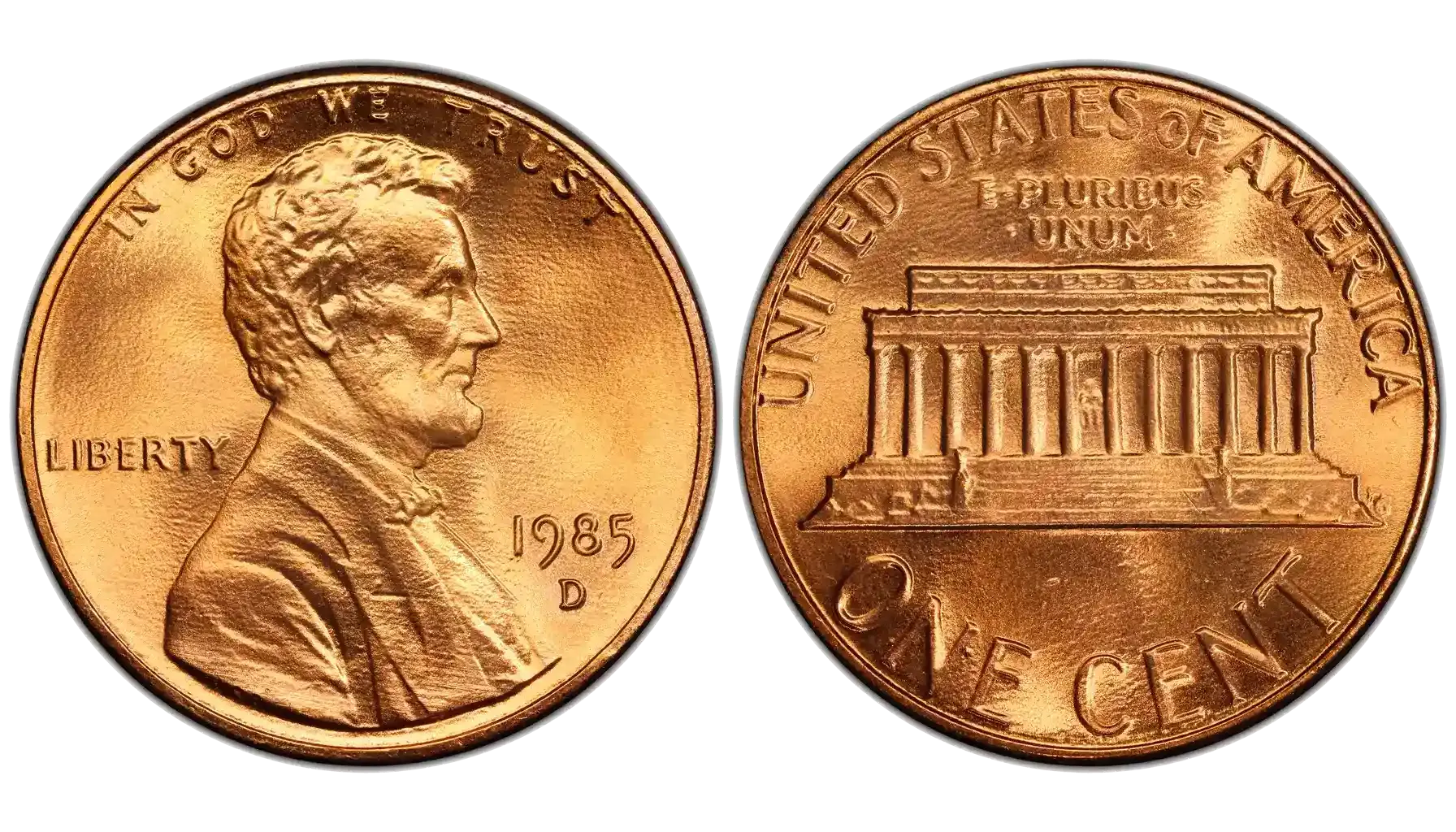
Identify by: There’s a “D” mint mark under the date on the obverse.
Mintage: 5,287,399,926.
Estimated value: $0.01 in circulated conditions, $25+ in uncirculated.
1985 D Penny Value is on par with the Philadelphia variety. Their mintages are too similar to significantly change the value.
1985 S Penny
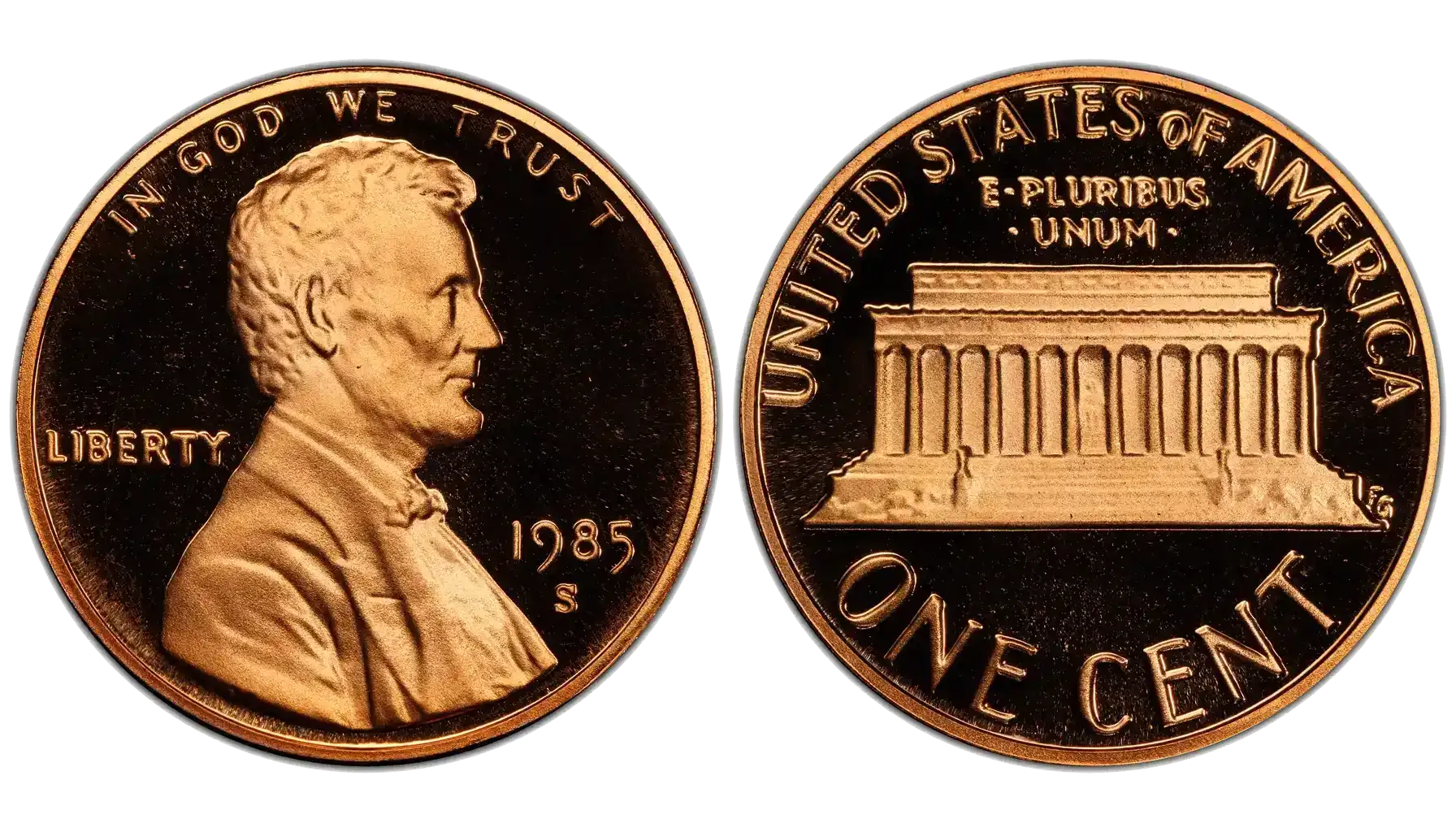
Identify by: There’s an “S” mint mark under the date on the obverse.
Mintage: 3,010,497.
Estimated value: $7+ in uncirculated.
The San Francisco mint historically made only a small number of coins, not intended for circulation. They are often called “proof pieces”. The 1985-S has a mirror-like finish with frosted devices.
It might be appalling that a penny with such a low mintage could be worth so little. The penny was made for non-circulation, so it was collected and stored carefully by many people. The coin lost its variety. If every piece is of excellent quality, the value of this quality speaks low.
Penny Grading
We’ve brushed the topic of coin grades when we talked about different varieties. Now, what is grading? It’s a system of determining the value of a piece, depending on how well the details were preserved.
If you want to know if a coin is worth money, get it graded.
Grade | Grade Name | Description |
G-4 | Good | Heavily worn; Lincoln's outline is visible, but details are mostly flat. |
VG-8 | Very Good | Still heavily worn, but major features are more distinct. |
F-12 | Fine | Moderate wear; more facial and hair details appear. |
VF-20 | Very Fine | Light to moderate wear; sharper details in face and coat. |
EF-40 | Extremely Fine | Light wear on high points; much of the design is clear and crisp. |
AU-50 | About Uncirculated | Slight trace of wear; full details and some luster remain. |
MS-60 | Mint State / Uncirculated | No wear, but may have dull luster, spots, or many contact marks. |
MS-63 | Choice Uncirculated | Nice luster, few noticeable marks, good eye appeal. |
MS-65 | Gem Uncirculated | Sharp strike, strong luster, and almost no marks. |
MS-67+ | Superb/Perfect Uncirculated | Nearly flawless; extremely rare in circulation strikes. |
1985 Penny Error List with Pictures
Coins with errors are very valuable. As long as a coin has an error, it can be a worthy investment even with a bad grade.
What are some common errors you might find on 1985 pennies?
Off-Center Strike
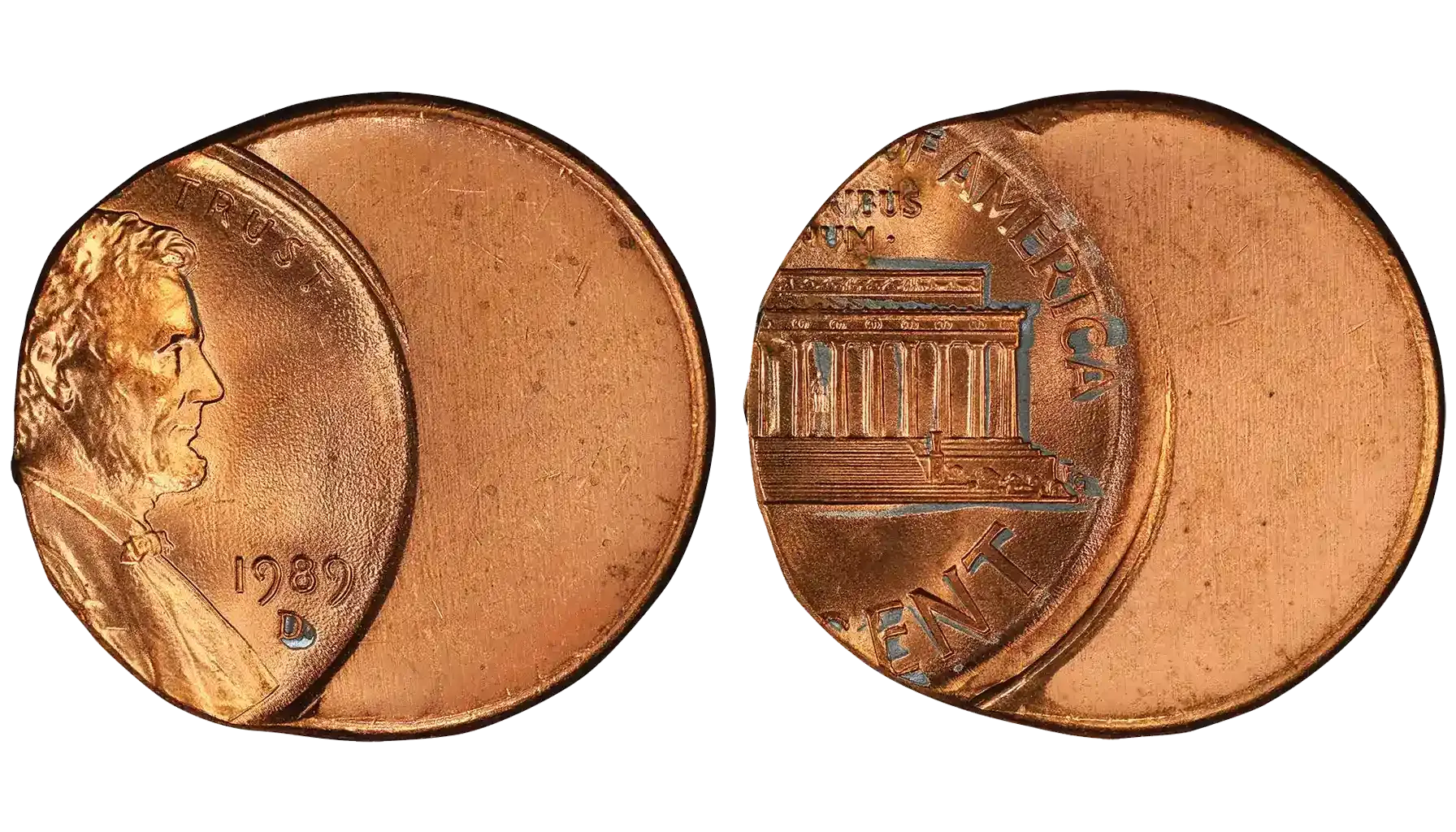
Identify by: The design on the coin is not centered. A part of it is seemingly missing, and what’s left is a blank space.
Value: $5 to $50+, depending on the percentage and visibility of the date.
When the press hits a coin, it might be put too far away from the center, which creates such an error. Off-centre errors are common for any coinage. The example from the picture is 1989, but 1986 pennies also have this flaw.
Clipped Planchet
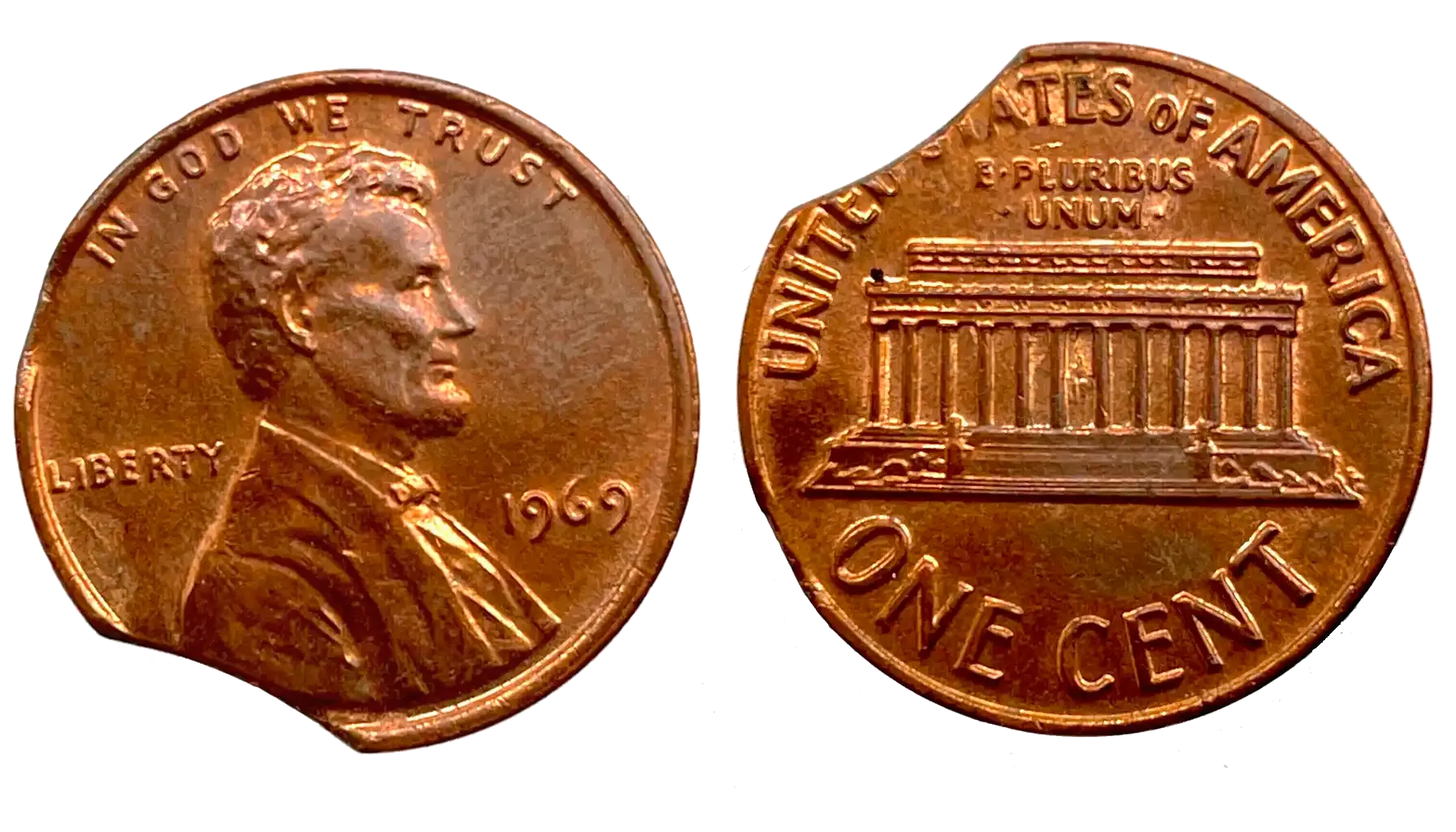
Identify by: The edge is missing, as if it was cut off. There’s a curve around the missing part.
Value: $10–$40 depending on the size of the clip.
A curved piece is missing from the edge due to a mistake in cutting the blank coin. Another common mistake that keeps happening even with modern coins like the 2009 Penny.
Broadstrike
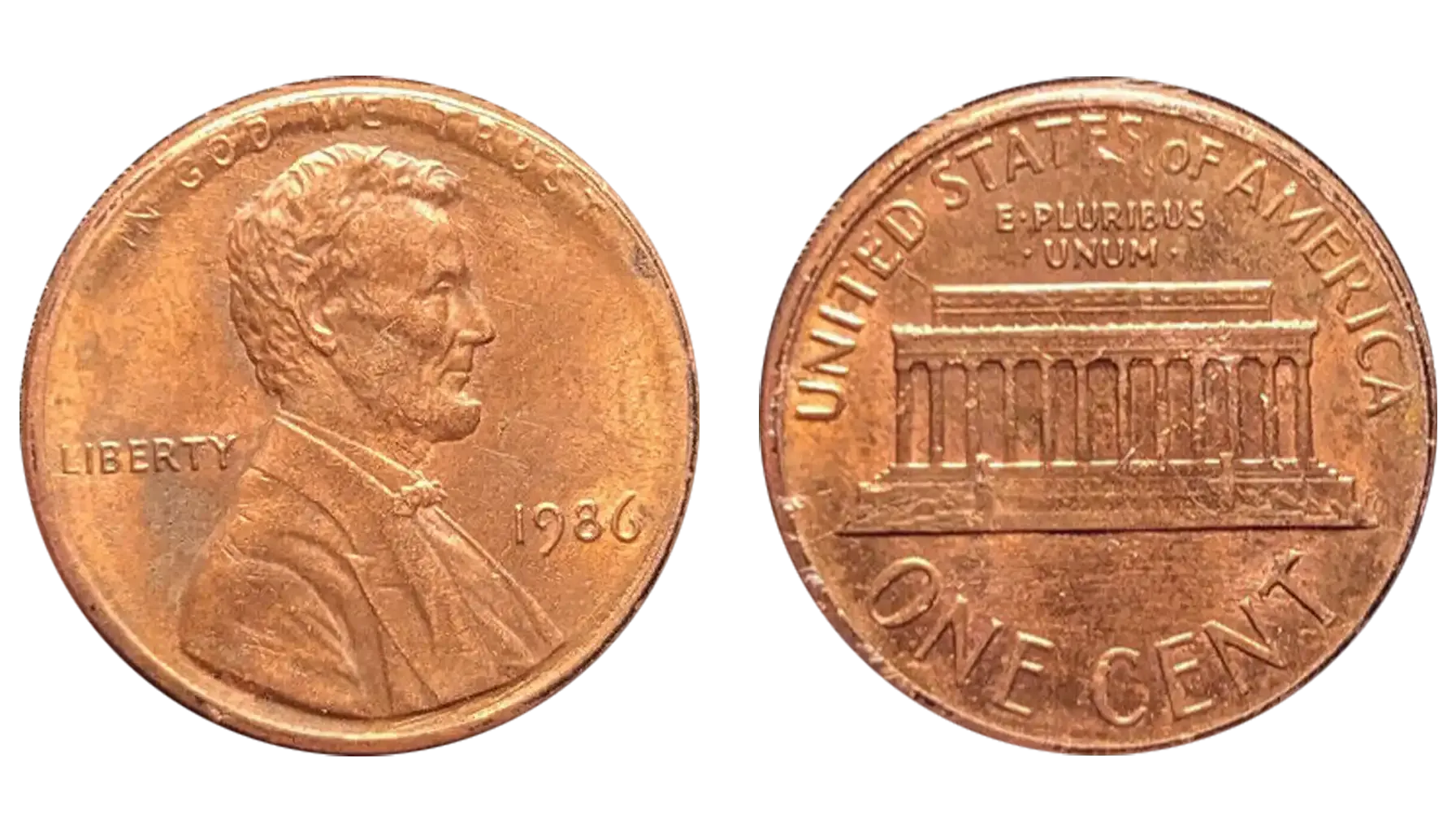
Identify by: The coin looks squashed and has little to no rim definition.
Value: $10–$30 range.
The coins are struck with the retaining collar. It helps to keep the shape. If the coin is struck without the collar, it causes the coin to appear stretched and flat with no rim.
Wrong Plating
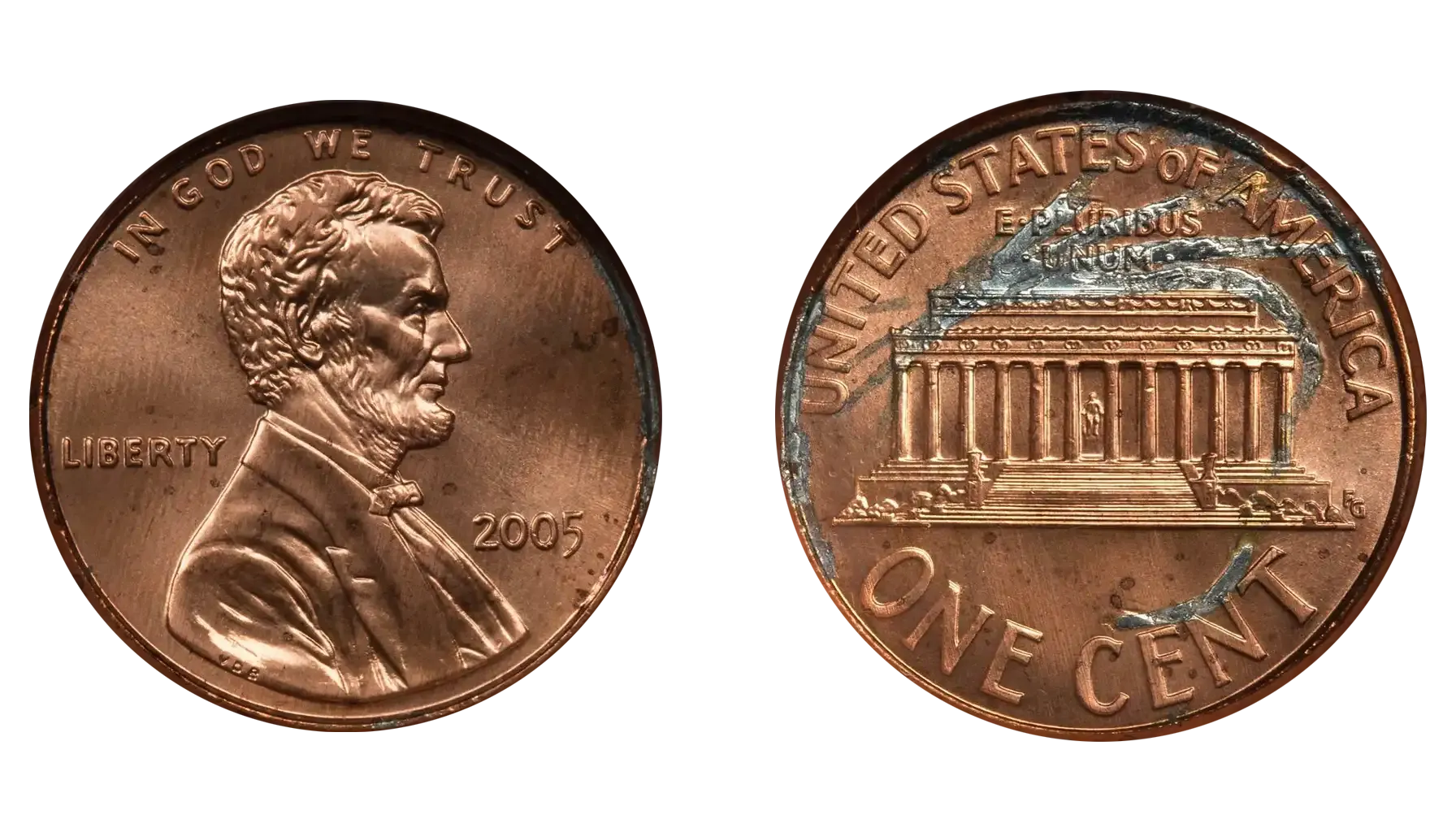
Identify by: The Surface of the coin has colour specs, and a different metal might be showing. There’s a silver colour where the copper should be.
Value: $50+.
Copper-based pieces often use plating, and if something goes wrong, another metal starts showing (nickel in this case). This valuable error is often mentioned on the 1985 D penny error list with pictures and other error pennies lists.
Double Die
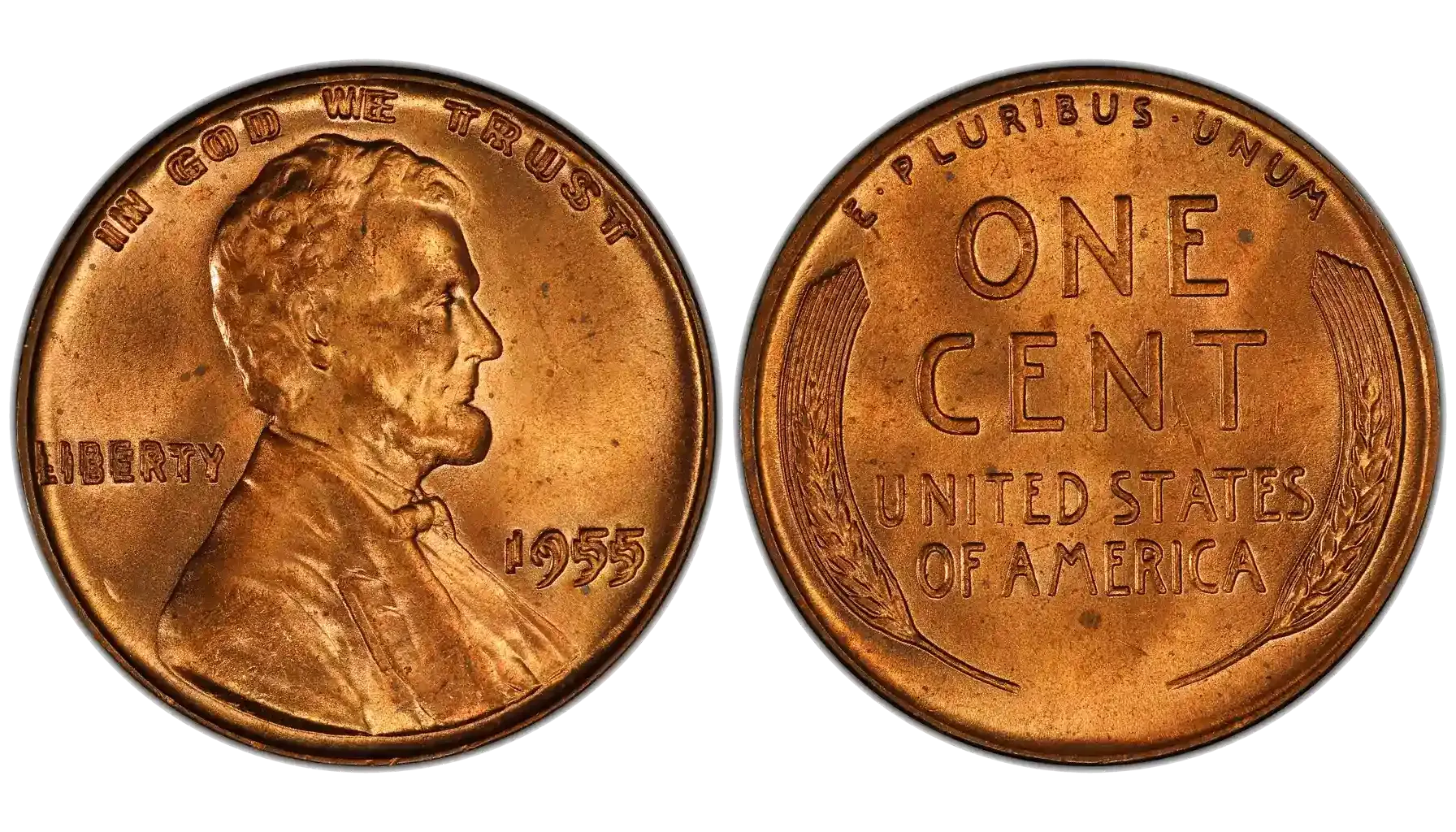
Identify by: Parts of the design appear doubled (especially in the date or lettering). Harder to notice on the 1985 no mint penny, as mint marks are often doubled too.
Value: $100+.
Double dies happen when the coin accidentally gets stamped twice. It’s a rare error, and coins like that get on the list of pennies worth money.
1985 Penny Worth
Grade / Condition | 1985 (No Mint Mark – Philadelphia) | 1985-D (Denver) | 1985-S (San Francisco – Proof) |
Circulated (G–XF) | $0.01 (Face Value) | $0.01 (Face Value) | – (Proof only) |
About Uncirculated (AU) | $0.10 – $0.20 | $0.10 – $0.20 | – |
MS-60 to MS-63 | $0.25 – $1.00 | $0.25 – $1.00 | – |
MS-65+ | $2.00 – $5.00+ | $2.00 – $6.00+ | – |
PR63 – PR67 | – | – | $1.00 – $6.00 |
PR68 – PR69 | – | – | $7.00 – $14.00 |
PR70 (Perfect Proof) | – | – | $200.00+ |
It seems that the 1985 penny value no mint mark is generally the same as the Denver counterpart, a bit overshadowed only in high grades. The S-mark seems to go for most value, but generally it’s still low.
It seems that only with 1985 penny errors can this coin be a worthy investment.
Bonus: What Makes a Coin Valuable
What makes a 1985-d penny rare (and any other coin for that matter)?
1. Rarity (Low Mintage or Surviving Numbers)
Coins that were minted in small numbers or have few known surviving examples are often more valuable.
Some coins are common but rare in high grades (e.g., MS67+).
2. Condition (Grade)
Coins in better physical condition are worth more.
Grading ranges from Poor (P-1) to Perfect Mint State (MS-70).
3. Errors or Varieties
Mint errors can dramatically boost value, especially if they’re dramatic (e.g., double die) and verified by third-party graders.
4. Metal Content
Some older coins have intrinsic precious metals, like Silver.
Your 1985 penny is copper-based, so unfortunately, it’s not as valuable.
5. Historical Significance
Coins linked to major events or changes (e.g., the first year of a design, the end of a series) can be valuable. For example, 1943 Penny went through the Second World War, raising the value.
Commemorative or transitional-year coins often carry collector interest.
Coin ID Scanner
Would you like to know more about your 1985 Lincoln cent and other coins? Here’s an app that can identify the coin and even give the approximate values. Coin ID Scanner.
The app uses AI to recognize over 150.000 coins from all over the world. Old pieces from Ancient Rome, commemorative coins, classic pieces, the app got them all.
If you have troubles or questions about coin collecting, there’s also an AI-Assistant and many blogs with good advice.
Download Coin ID Scanner today for your iOS/Android device.



